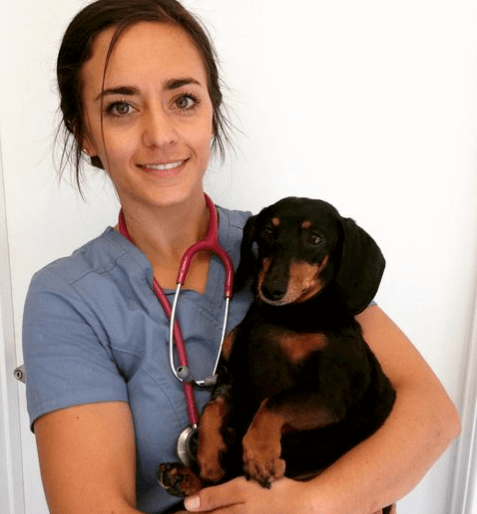🦴 Updated on July 8th, 2023

If you are considering a mini Australian Shepherd, you might be charmed by their sweet faces and soft, fluffy coats. Aussies are one of the most popular breeds in the world, and mini Aussies have become even more famous for their size.
However, preparing for a dog is about more than just cuteness and snuggles. You must also consider the practical side of owning a dog. For most dog owners, a leading question is: how much will this dog shed?
If you’re wondering whether Mini Australian Shepherds shed (and how much), you’ve come to the right place.
Do Mini Australian Shepherds Shed?
Mini Australian Shepherds are excellent dogs if you love Australian Shepherds but want a slightly smaller pup. With high energy and intelligence, Mini Aussies make great family dogs and work well with kids and other dogs.
However, this might not be the breed for you if you’re looking for a dog that doesn’t shed much. Like their larger counterparts, Mini Australian Shepherds shed quite a bit throughout the year, with a twice-yearly coat drop.
With proper maintenance and care, this amount of shedding is manageable. However, if you’re looking for a hypoallergenic dog or trying to keep your house fur-free, a mini Aussie will not be compatible with your lifestyle. Here is a complete guide to Aussie shedding and how to manage it.
How Much Do Mini Australian Shepherds Shed?
Mini Australian Shepherds shed just as much as their larger counterparts, regular Australian Shepherds.
The only difference you will see is in the animal’s size – a smaller dog sheds less because he has less fur. However, minis will still leave tufts of fur around your house, especially during high-shedding seasons.
Of course, the amount of shedding depends a little on the particular dog. Factors such as hormones, weather, and sex affect how much a dog sheds. However, the difference between one Aussie and another is minimal because they all have a double coat and will need to shed it at some point.
Mini Australian Shepherd Shedding Level
According to the AKC, a mini Australian Shepherd’s shedding is usually medium. However, the two times of the year that it becomes necessary to shed the dog’s undercoat, the level jumps up to high.
A medium-level shedding dog won’t differ much from a golden retriever or a lab. Most of the year, you vacuum after your dog and brush it once a week, which is normal for a dog owner. However, your mini Aussie pup will have more high maintenance requirements during fall and spring.
Why Do Australian Shepherds Shed?
Australian Shepherds have short hair and a double coat. The top layer keeps them warm in winter and safe from inclement weather, while the bottom coat provides insulation against the elements.
Both layers are fur, which eventually dies and falls out as new fur grows in; this is why most dogs do not need haircuts or regular grooming.
Dogs shed to keep themselves cool in the summer, warm in the winter, and comfortable in the seasons in between.
They also may shed when stressed, although excessive shedding isn’t always a sign of stress or illness. Aussies shed as they grow, so you might not see as much shedding in the first year of owning a puppy.
Mini Aussie Shedding Throughout the Seasons
In addition to the regular shedding cycle of a dog, breeds with double coats have a seasonal shedding pattern.
Although most dogs live comfortably inside the house and don’t need protection from winter, the evolutionary habits of being an outdoor or farm dog have programmed Aussies to shed their undercoats and grow new ones twice a year.
Mini Aussies shed their coats in fall and spring to accommodate a new coat for the season. The lighter summer coat sheds in fall, and a heavier winter coat grows in. When spring rolls around, the opposite happens. In both seasons, you’ll need to groom your dog more and will still find tufts of fur wherever she has been.
Mini Australian Shepherd Coats
Mini Australian Shepherds have two coats, an outer coat, and an inner coat, both of which give them optimal protection from winter weather and rain. Aussies that are working dogs herding sheep or working outdoors make sure of these coats. However, it does lead to shedding.
Like Australian Shepherds, mini Aussies have luxurious, shiny, merled coats. They can have small dapples of color or large blotches, but the Aussie coat is one of the most beautiful dog breeds to look at. However, it does take some work to care for, especially during shedding season.
Even when Aussies are shedding the most, their coats look full and thick, and this is because when the undercoat sheds, the fur can grow back in without any exterior change. Also, dogs only shed fur as they grow, so the replacement rate is relatively even.
How To Care for a Mini Australian Shepherd Coat
For most of the year, the main care you’ll have to give your mini Aussie is brushing. You’ll need a specially formulated brush for short-haired double-coated dogs. Usually, this brush will have longer spines and a way to push the fur out between brushes.
Keeping an Aussie’s coat healthy during the summer and the winter will just include proper feeding, exercise, and brushing fur once a week. Regular care will automatically take care of most of the dead fur and reduce the dog fur you’ll find on your floors and couches.
However, during shedding season, Aussies lose hair in huge clumps. To keep their fur growing quickly and smoothly, you’ll have to brush it once or twice daily. You’ll know when it’s time because your home will have a layer of dog fur on most open surfaces. Brushing once a day won’t take care of this, but it will help the problem.
Mini Aussie Grooming Needs
Mini Aussies don’t have hair; they have fur, which prevents them from being hypoallergenic, meaning they will shed more than some dogs. However, it also means that you shouldn’t have to take your Aussie to a groomer, as their fur will primarily take care of itself.
However, you will occasionally need to bathe your dog and brush out its hair. Regular brushing prevents matting and tangles. If a dog’s fur gets too tangled, you or a vet need to cut out the mats, resulting in a less healthy coat.
While keeping a dog healthy and trimming its nails regularly is essential, frequent brushing is the only care you’ll have to give a mini Aussie. If you use the correct brush and brush your pup once a week, usually and once a day during shedding seasons, your dog will have a healthy and happy coat.
How To Prevent Excess Shedding
Although you won’t be able to prevent shedding entirely, there are ways to help your mini Aussie shed less. Regular brushing helps keep the fur healthy and prevent excess shedding, which can be nice if you use the brushing time as bonding with your dog (some dogs don’t like it, and that’s okay).
Another way to ensure that your dog doesn’t shed more than necessary is to ensure he is comfortable temperature-wise. An overheated or stressed dog sheds more (you might notice more shedding at the vet or in another stressful situation for your pet). While you can’t stop this, you can minimize it as much as possible.
Tips for Living With a Mini Aussie With Allergies
If you or one of your loved ones has dog allergies, a mini Aussie pup is not the best option. Because they have a medium to high level of shedding, you won’t be able to avoid the dander entirely. However, if you have a visitor with allergies, here are some tips to keep the exposure to a minimum:
- Vacuum before the visitor arrives, especially on sitting surfaces the dog has been on
- Relegate the dog to a specific area of the house (like a bedroom or hallway the visitor won’t be in) while the visitor is there
- Keep the windows open
- Have allergy meds on hand
- Make sure the area your visitor will be staying in is fur-free, and you wash everything before the arrival
- Try to keep your pup outside as much as possible
Frequently Asked Questions
Here are some frequently asked questions about Mini Aussies and their fur level. We hope they answer your questions and help you pick the perfect dog for your family!
Are Mini Aussies good house dogs?
Mini Aussies have a lot of energy and were initially bred to be cattle and sheep dogs. They have a history of working and performing in dog shows and other high-intelligence competitions. However, these dogs live well in a house as long as they have the right amount of exercise and mental stimulation.
Are Mini Aussies hypoallergenic?
Mini Aussies are not hypoallergenic. They shed a lot of fur and dander, and anyone with a dog allergy will likely react strongly to a Mini Aussie. While the dogs shed less in the summer and winter, they will still leave dander and fur around, which is unsafe for allergy sufferers.
What breeds make a Mini Aussie?
Although many “mini” breeds come from the breeding of a smaller breed with a larger one, the Mini Aussie is still a purebred Australian Shepherd. These dogs were selectively bred over the years with smaller Aussies until they received recognition as a breed.
Do Mini Aussies bark a lot?
Unlike many smaller dog breeds, a Miniature Australian Shepherd won’t bark too much. Although personality varies for each dog, most mini Aussies will only bark when they want to draw your attention to something. Usually, one or two barks will be enough to let you know, and they will calm down.
Final Thoughts
Although Mini Aussies shed quite a bit, the shedding is manageable throughout the year. For the few months that it isn’t and your pup is leaving tufts of fur all over the place, you will be able to handle it with extra brushing and vacuuming. An Australian Shepherd Puppy is worth the work if you are willing to handle the cuteness!


